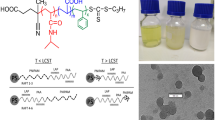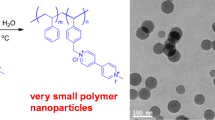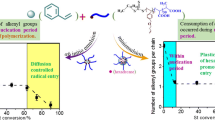Abstract
Reactive oligomers of styrene–maleic anhydride having controlled architecture were prepared using reversible addition fragmentation chain transfer (RAFT) polymerization. The co-oligomers were characterized by FTIR, Raman, NMR and GPC. The arrangement of co-monomers (i.e. the architecture) in the co-oligomeric RAFT agents could be controlled by changing the molar feed ratio of styrene to maleic anhydride in the range of 1–5.25 under controlled polymerization conditions. Non-alternating (homopolymer) blocks of styrene could be suppressed even at high mole ratios > 1 and the resultant co-oligomeric RAFT agents consisting of mainly alternating (SMS) and semi-alternating (SSM) sequences of styrene and maleic anhydride were obtained. These macro RAFT agents behaved as efficient reactive surfactants and their self-aggregation behavior was greatly influenced by their architecture. These could be successfully used for surfactant-free nanoencapsulation of active hydrophobic materials, such as n-octadecane, indicating their suitability for various applications.










Similar content being viewed by others
References
Baglioni M, Raudino M, Berti D, Keiderling U, Bordes R, Holmberg K, Baglioni P (2014) Nanostructured fluids from degradable nonionic surfactants for the cleaning of works of art from polymer contaminants. Soft Matter 35:6798–6809
Bapat AP, Ray JG, Savin DA, Hoff EA, Patton DL, Sumerlin BS (2012) Dynamic-covalent nanostructures prepared by Diels–Alder reactions of styrene-maleic anhydride-derived copolymers obtained by one-step cascade block copolymerization. Polym Chem 3:3112–3120
Baskar G, Landfester K, Antonietti M (2000) Comblike polymers with octadecyl side chain and carboxyl functional sites: scope for efficient use in miniemulsion polymerization. Macromolecules 33:9228–9232
Benoit D, Hawker CJ, Huang EE, Lin Z, Russell TP (2000) One-step formation of functionalized block copolymers. Macromolecules 33:1505–1507
Buchak BE, Ramey KC (1976) Monomer sequence distribution in styrene-maleic anhydride copolymers. J Polym Sci Polym Lett Ed 14:401–405
Butler GB, Do CH, Zerner MC (1989) The stereochemistry of styrene-maleic anhydride copolymers: 13C-NMR study and PVCILO and INDO/1 calculations. J Macromol Sci Chem 26:1115–1135
Davies MC, Dawkins JV, Hourston DJ (2005) Radical copolymerization of maleic anhydride and substituted styrenes by reversible addition-fragmentation chain transfer (RAFT) polymerization. Polymer 46:1739–1753
De Paz Banez M, Robinson K, Vamvakaki M, Lascelles S, Armes S (2000) Synthesis of novel cationic polymeric surfactants. Polymer 41:8501–8511
Durand A, Marie E (2009) Macromolecular surfactants for miniemulsion polymerization. Adv Colloid Interface Sci 150:90–105
Gupta A, Eral HB, Hatton TA, Doyle PS (2016) Nanoemulsions: formation, properties and applications. Soft Matter 11:2826–2841
Ha NTH (1999) Determination of triad sequence distribution of copolymers of maleic anhydride and its derivates with donor monomers by 13C NMR spectroscopy. Polymer 40:1081–1086
Hill MR, Carmean RN, Sumerlin BS (2015) Expanding the scope of RAFT polymerization: recent advances and new horizons. Macromolecules 48:5459–5469
Klumperman B (2010) Mechanistic considerations on styrene–maleic anhydride copolymerization reactions. Polym Chem 1:558–562
Kooij VD, Hanne M, Sprakel J (2015) Watching paint dry; more exciting than it seems. Soft Matter 32:6353–6359
Lessard B, Maric M (2009) One-step poly (styrene-alt-maleic anhydride)-block-poly (styrene) copolymers with highly alternating styrene/maleic anhydride sequences are possible by nitroxide-mediated polymerization. Macromolecules 43:879–885
Lu F, Luo Y, Li B (2007) A facile route to synthesize highly uniform nanocapsules: use of amphiphilic poly(acrylic acid)-block-polystyrene RAFT agents to interfacially confine miniemulsion polymerization. Macromol Rapid Commun 28:868–874
Luo Y, Gu H (2006) A general strategy for nano-encapsulation via interfacially confined living/controlled radical miniemulsion polymerization. Macromol Rapid Commun 27:21–25
Luo Y, Gu H (2007) Nanoencapsulation via interfacially confined reversible addition fragmentation transfer (RAFT) miniemulsion polymerization. Polymer 48:3262–3272
Manguian M, Save M, Chassenieux C, Charleux B (2005) Miniemulsion polymerization of styrene using well-defined cationic amphiphilic comblike copolymers as the sole stabilizer. Colloid Polym Sci 284:142–150
Moad G, Rizzardo E, Thang SH (2009) Living radical polymerization by the RAFT process—a second update. Aust J Chem 62:1402–1472
Nakahara Y, Kida T, Nakatsuji Y, Akashi M (2005) New fluorescence method for the determination of the critical micelle concentration by photosensitive monoazacryptand derivatives. Langmuir 21:6688–6695
Parida D, Serra CA, Bally F, Garg DK, Hoarau Y (2012) Intensifying the ATRP synthesis of statistical copolymers by continuous micromixing flow techniques1. Green Process Synth 1:525–532
Park C, Yoon J, Thomas EL (2003) Enabling nanotechnology with self assembled block copolymer patterns. Polymer 44:6725–6760
Pham BT, Nguyen D, Ferguson CJ, Hawkett BS, Serelis AK, Such CH (2003) Miniemulsion polymerization stabilized by amphipathic macro RAFT agents. Macromolecules 36:8907–8909
Quinn JF, Rizzardo E, Davis TP (2001) Ambient temperature reversible addition–fragmentation chain transfer polymerisation. Chem Commun 11:1044–1045
Roth H, Arnold M, Rätzsch M (1981) 13C-NMR-Untersuchungen an Styren-Maleinsäureanhydrid-Copolymeren. Acta Polym 32:277–280
Schoukens G, Martins J, Samyn P (2013) Insights in the molecular structure of low-and high-molecular weight poly (styrene-maleic anhydride) from vibrational and resonance spectroscopy. Polymer 54:349–362
Sirohi S, Singh A, Dagar C, Saini G, Pani B, Nain R (2017) Facile synthesis of microporous SiO2/triangular Ag composite nanostructures for photocatalysis. Appl Nanosci 8:633–643
Stoffelbach F, Belardi B, Santos JM, Tessier L, Matyjaszewski K, Charleux B (2007) Use of an amphiphilic block copolymer as a stabilizer and a macroinitiator in miniemulsion polymerization under AGET ATRP conditions. Macromolecules 40:8813–8816
Xiong Q, Ni P, Zhang F, Yu Z (2004) Synthesis and characterization of 2-(dimethylamino)ethyl methacrylate homopolymers via aqueous RAFT polymerization and their application in miniemulsion polymerization. Polym Bull 53:1–8
Yao Z, Zhang JS, Chen ML, Li BJ, Lu YY, Cao K (2011) Preparation of well-defined block copolymer having one polystyrene segment and another poly(styrene-alt-maleic anhydride) segment with RAFT polymerization. J Appl Polym Sci 121:1740–1746
Zeng W, Shirota Y (1989) Studies on alternating radical copolymerization: analysis of microstructures of styrene-maleic anhydride, styrene-acrylonitrile, and styrene-methyl methacrylate copolymers by fluorescence spectroscopy. Macromolecules 22:4204–4208
Acknowledgements
The authors acknowledge partial financial support provided by Department of Science and Technology, Govt. of India under various research grants. One of the authors (S. Sirohi) would like to thank Bhaskaracharya College of Sciences (University of Delhi) for providing opportunity to pursue Ph.D. under which this work was carried out.
Author information
Authors and Affiliations
Corresponding authors
Ethics declarations
Conflict of interest
On behalf of all authors, the corresponding author states that there is no conflict of interest.
Additional information
Publisher’s Note
Springer Nature remains neutral with regard to jurisdictional claims in published maps and institutional affiliations.
Electronic supplementary material
Below is the link to the electronic supplementary material.
Rights and permissions
About this article
Cite this article
Sirohi, S., Jassal, M. & Agrawal, A.K. Surfactant-free nanoencapsulation using reactive oligomers obtained by reversible addition fragmentation chain transfer polymerization of styrene and maleic anhydride. Appl Nanosci 8, 1701–1710 (2018). https://doi.org/10.1007/s13204-018-0845-2
Received:
Accepted:
Published:
Issue Date:
DOI: https://doi.org/10.1007/s13204-018-0845-2




